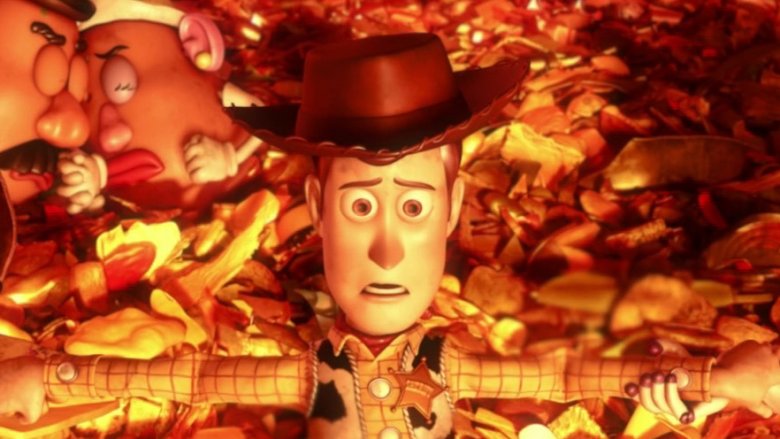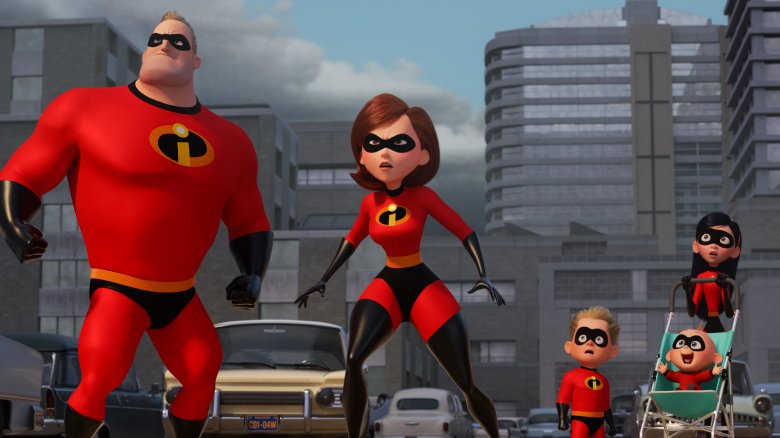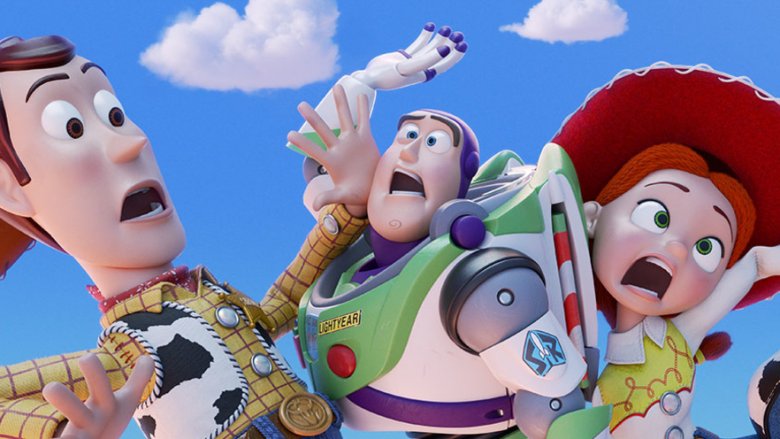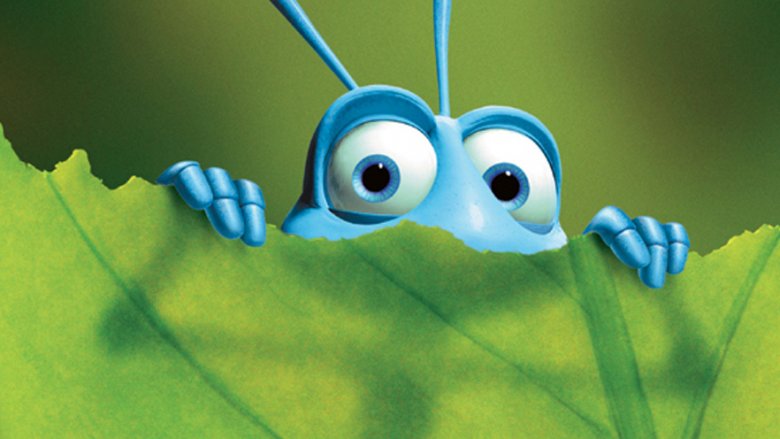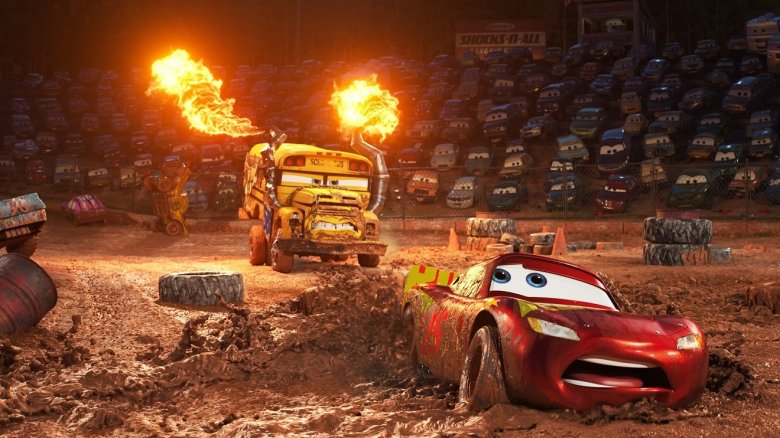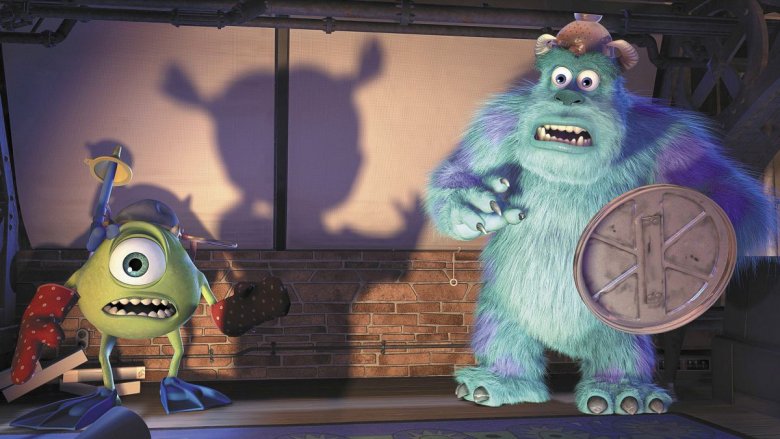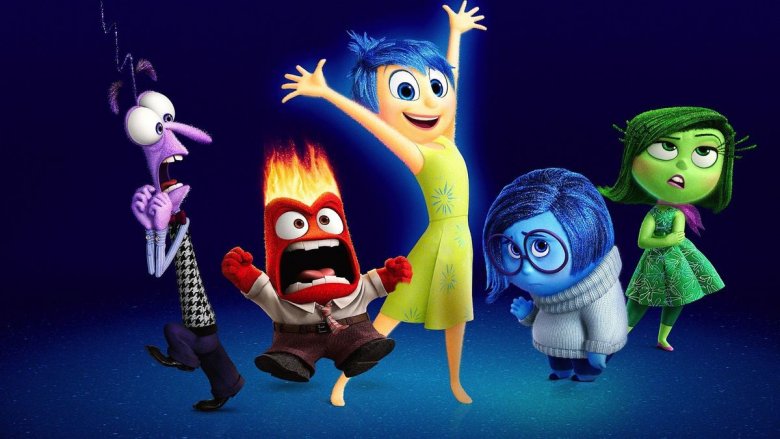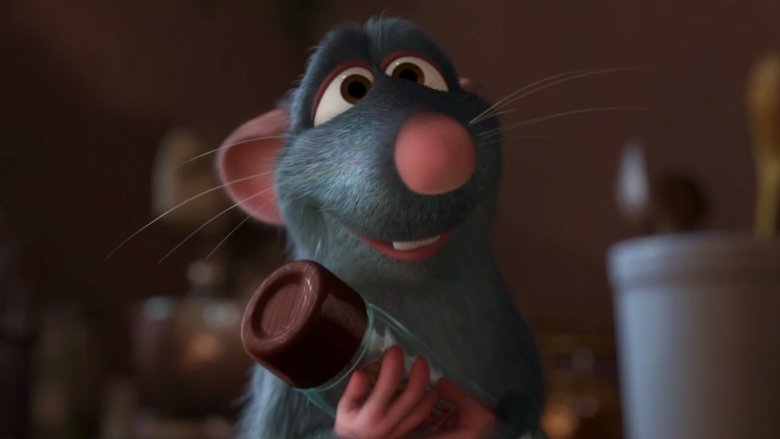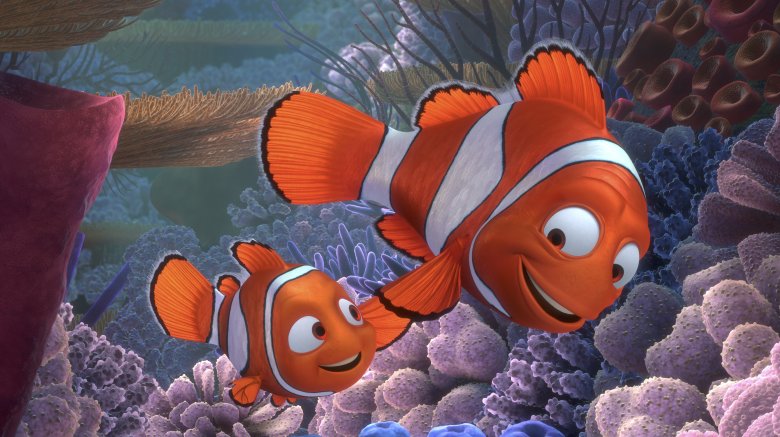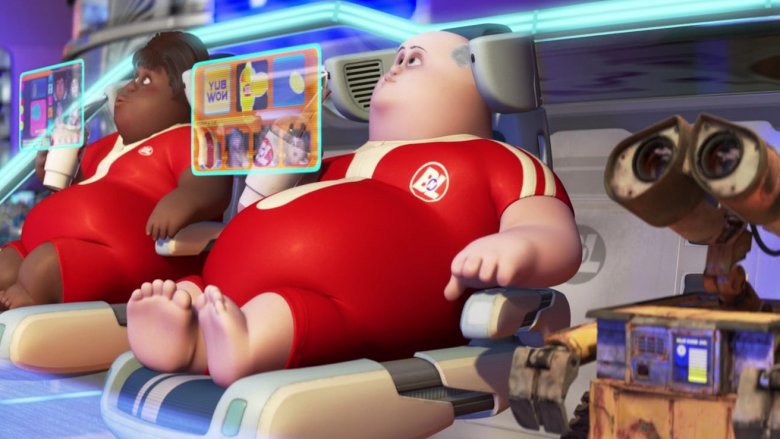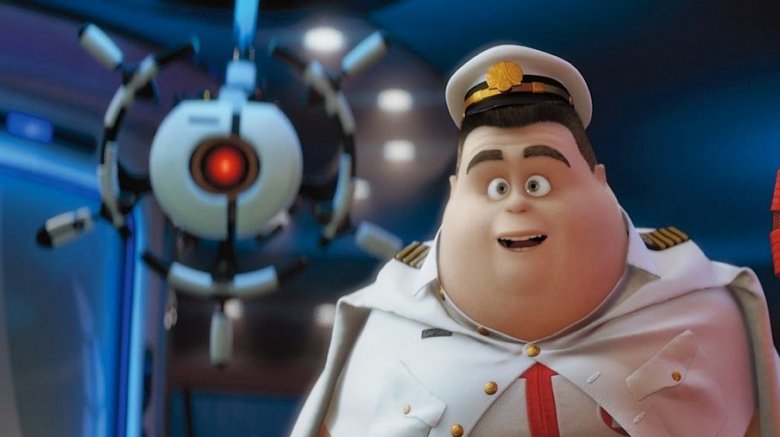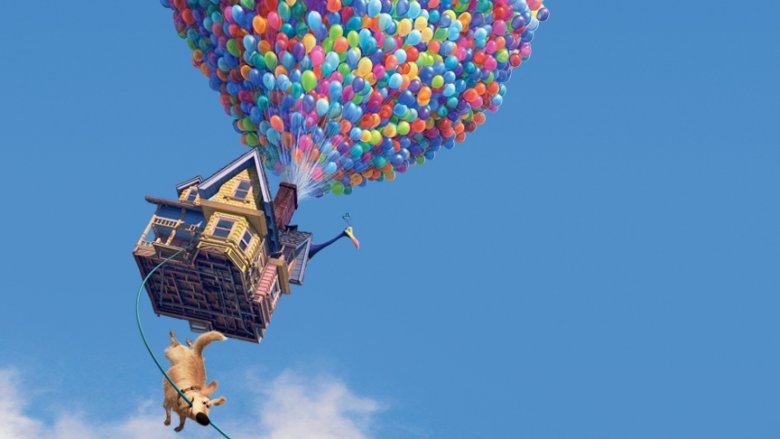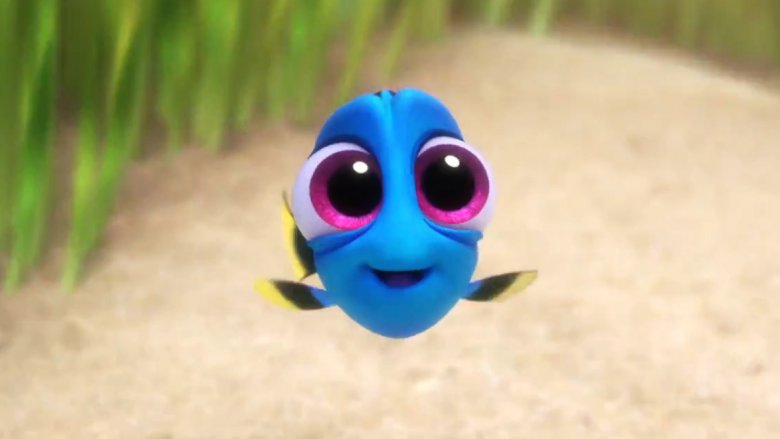Messed Up Things In Pixar Movies Nobody Talks About
Pixar. From humble beginnings as an animation firm for TV advertisements it's become one of the most famous, successful, and (most amazingly) consistently excellent studios in America. Pixar has a habit of hitting you with the old one-two punch, throwing you off balance with deceptively adorable characters then punching you out with Ellie's miscarriage in Up or Toy Story 3's spiraling inferno full of your favorite childhood toys. But those are the obvious ones, the ones that stare you right in the face.
Considering their apparent love of gut-slapping audiences with emotional trauma, maybe it shouldn't be a surprise that these pixel pushers have crammed more than a few atrocities into their movies — things that come off as background noise at first blush but unfold into horror like a Demogorgon mouth when given a second glance. Let's take a look at a few of the most horrifying details in the Pixar canon.
The Incredibles kill people
Back in 2004, the cinematic superhero arms race was just heating up. Batman had not yet Beginned. The MCU was still 15 percent of a twinkle in Robert Downey Jr.'s agent's eye. The idea of a Spider-Man reboot was laughable because we all knew in our hearts that Tobey Maguire was all we'd ever need. It was a simpler time.
So when Pixar came out with its shockingly deep, retrofuture take on silver age comic book characters, the world was more than a little tickled. The Incredibles charmed audiences all over the world by not-entirely-subtly taking the Fantastic Four, Marvel's "First Family," and asking "what if they actually acted like a family?" And then, presumably, they mutter-coughed "the Manson family" and crept off to their studios, twirling their mustaches and cackling.
It's easy to miss it with everything happening on screen, but the Incredibles straight up murder a lot of people. Bob, the patriarch, does most of the human culling, tossing henchmen off cliffs and crushing a couple dudes with a boulder. When you start counting up the number of murders committed by his children, though, things turn an especially spicy flavor of appalling. Violet uses a force field to crash a hovercraft, and Dash knocks down a pair of the same with a palm tree, presumably only repressing the urge to shout "face plant!" and then sip a martini like James Bond because he's 9 years old.
The souls of toys are trapped in a philosophical hellscape
Here's a thought experiment called Theseus' Paradox: If a guy (let's call him Theseus) has a boat, and one day he replaces the sails, and then a little later, he replaces the mast, then the hull, then eventually every part of it, is that still his boat? It's amusing. It gets less amusing if you imagine that the boat has a conscious mind and that all its component parts remain lucid while they're torn off and repurposed as, say, firewood.
And that's the world of Toy Story.
See, in Toy Story, we're presented with the idea that all the inanimate objects we've given to our children are very much alive. We further see that when Sid, the boyish sociopath from the house next door, rips toys apart and Frankensteins them back together, his patchwork monster mashes present themselves as individuals. So what happened to the consciousnesses of the proverbial toy eggs that Sid broke to make his toy omelette? Are they dead? Do they become a combined mental amalgamation within the new creation? Where does the toy's soul live, and how much of its physical form has to be replaced before a new life is created? Are you going Rosemary Kennedy on your Buzz Lightyear's brain every time you replace his batteries?
A Bug's Life means kids are monsters
A Bug's Life doesn't get the love that it deserves. Maybe it didn't actively try to make you cry like a kid at a kitten smashing factory the way every other Pixar movie did, but it had a lot of heart, and what's more, it will be remembered fondly by future generations as the cartoon about ants that helped bar Woody Allen from making more kids movies.
At the heart of the story is Flik, voiced by Dave Foley. He's a worker ant with big dreams. He's desperately enamored with the future queen of the colony, which is cute if you forget that ant mating is less Romeo and Juliet and more like a hardcore blue movie produced by H.R. Giger, and strap in because that's not even the worst part of what's about to be said.
Consider that description of Flik. He has dreams. Dreams. He wants more. He's shown to be capable of individual thought, planning a massive deception involving complicated engineering. He does all this with a clear goal in mind. While he's certainly an outlier, the other ants in his mound were just as aware. They weren't drones; they were alive.
So long story short, every kid that's ever fried a bug with a magnifying glass is a war criminal. Look into Flik's eyes. He knows what you did.
The cars in Cars are living on borrowed time
Cars, Cars 2, Cars 3, and spin-off Planes are consistently voted as tied for first on the list of movies that make you pause and go "wait, that's the Pixar franchise with the most sequels?" Are they the best? They aren't. Do they have more Larry the Cable Guy than most children's entertainment? They do. Are they secretly taking place in a nightmarish post-apocalypse where man has died and machines rule the wastes? They probably totally are.
It's a widely circulated fan theory that the Cars movies take place in a world where humanity was snuffed out ages ago. It makes sense: The leftovers of our time on Earth are all around, from the Eiffel Tower to the cars themselves. Depressing? Sure. Here's where it gets worse.
The cars in Cars are going to run out of gasoline and sputter into the great beyond in little to no time at all. Consider this: Every car on the planet is now at least idling 24 hours a day. Now think about how, at our current rate of production, it's estimated that humans will run out of petroleum in the next five decades. That means these characters have, at best, 50 years to live, and that's only if they've figured out how to extract and refine oil. If they're just running on the reserves that were left in the Dinoco stations when all the people died off, it's amazing that Lightning McQueen has lasted this long, or else just a few wealthy have sucked up all the gas and left countless others to die early.
The Monsters, Inc. monsters are actual monsters
Mike and Sulley are hard not to love, as long as you don't mind that they've doomed humanity through inaction.
Yes, those adorable monsters are actual monsters. They've killed us all with their reclusivity and inability to function outside of the shadows. They claim to love us, even going so far as to alter the entire structure of their society just so our children won't have to be scared all the time. What they won't do is lift a finger to stop us from dying en masse.
The monsters of Monsters, Inc. have access to what sure appears to be clean, renewable energy so powerful that their entire world is run on it. The source of their power? Kids making noise. Figuring that all kids do is make noise, and all people do is make kids, this technology would forever change not only science, but the human race as a whole. Consider the hundreds of thousands of lives that have been lost over limited resources, even just in the hundred or so years since we started relying on gasoline. All of that could be over in a matter of days. All the monsters would have to do is say "Hey, don't shoot, we brought you this box of world peace."
Rather than share their scream engine, however, they decided to stay hidden and, if the latest carbon emissions studies are any indication, doom human beings to cook themselves to death. Sorry, Boo!
Inside Out means you're a hive mind, not an individual
The human brain is still very much a mystery. What is it that makes us human? Are we truly in control of our own actions? Are we simply a collection of proteins gifted with illusory self-awareness through a benevolent fluke of molecular physics?
"No," says Pixar. "The truth is so much darker than that."
In the world of Inside Out, a human mind is simply a hub from which unobservable forces play god with our very being. Any feeling that a person has is simply the result of actions carried out by personified totems of the human emotional experience. Working together, these creatures are responsible for every facet of our lives. They form our relationships. They make our choices.
So what does that make us? Either puppets whose strings are tugged with reckless disregard for the very concept of free will, or perhaps more terrifyingly, mental corporations with no more individuality than a publicly traded corporation whose board members literally wrestle for control of the company. We are meat sacks, tossed around by the whims of forces we will never understand.
And you know what's worse? One of them is Lewis Black.
Remy probably killed a lot of people
Everyone loves a Cinderella story. The unlikely hero chases their dreams and winds up at the top against all odds, and, in the Brothers Grimm version at least, their step-sisters' eyes get slashed to ribbons by sparrows. Yeah, German kids' stories are dark.
Not as dark as Ratatouille, though. In Ratatouille, we're given an underdog who desperately deserves to be an underdog. No, not deserves. Needs. Remy is a common rat, a member of a species which, while not without its charms, doesn't belong anywhere near a kitchen. Disregarding the historical prevalence of rodent-borne diseases, he lives in a French sewer, a place with a history of killing people who work there part-time due to exposure to chemicals and pathogens that living creatures should avoid whenever possible. And every time he scuttled into a kitchen, Remy brought a little bit of that with him.
What's more, during the film's third act, a veritable Muppets Take Manhattan's worth of rats takes control of the kitchen. They prepare food for tables full of patrons who will finish their meals, disperse out around the city, and unknowingly spread a modern plague that the human race is ill equipped to combat. In conclusion, there's a reason why we have rules about rodents in restaurants. There are easier ways to spread super-cholera, but not many.
This is the Nemo normal
Taking inspiration from nature is a double-edged sword in the family entertainment industry. Yeah, an anthropomorphized animal character is instantly recognizable to your target audience, but an hour on Wikipedia later and those kids are going to be bleaching their eyes trying to unread the fact that Mufasa would've probably eaten Simba at some point.
It only gets weirder when you look at the ocean, where wildlife and night terrors collide. Case in point: the clownfish. These orange and black charmers exhibit a quality called protandrous hermaphroditism, meaning they switch sexes from time to time. Generally, it's out of necessity: social groups of clownfish generally only have one breeding female, and if she dies, the family's breeding male will turn into a lady fish, and the next largest juvenile in the group will grow rapidly and begin mating with the newly re-pronouned den mother.
So for everyone keeping score at home: When Nemo's mom died, Nemo's dad should've gone through some changes and then Nemo should've tried to get her pregnant. Yowza.
The humans in Wall-E just don't care
When it comes right down to it, Pixar doesn't seem to think very highly of us human beings. They've got a good bead on our complexities, but overall, they tend to shine a dim light on us. We're unwitting marionettes. We're psychotic toy butchers. Rats can cook better than we can. In Wall-E, though, we're the actual worst, and it's not for the reason you think.
Wall-E shows us a possible future where man's laziness has destroyed the Earth and led to species-wide obesity and the Age of the Big Gulp. More than that, though, it presents us with a society held together entirely by robots. It's kind of cool, really. We've designed machines for every task, and with the occasional space coup aside, they seem to do a pretty good job. There's just this one quirk: Apparently, they're all capable of emotions like love and joy.
It's not subtle, either. From what we see, any machine left running long enough develops a personality and feelings. That's the sort of thing that people would notice when their computer monitors started killing themselves because they felt unadmired. So basically, we created a slave caste out of whole cloth and then never changed our approach to production when we realized they were sentient. Why do you hate people, Pixar? We're the ones who keep seeing your movies.
And Wall we're at it...
Man, this day is not getting any better for robots.
More bad news: Things are probably not getting any better for the machines after Wall-E is over. Despite the presentation of a loving and environmentally sound future during the credits, humans have now regressed to the point of being physically and mentally incapable of caring for themselves. They weigh several times what their average ancestor did, having long since tipped past the point of a scooter cart doing them any good at the grocery store. This means they'll be more reliant on robots than ever before in the harsh, regular-gravity environment of the planet's surface.
We're talking about physical therapy robots. Emergency medical robots. Probably parasol-holding robots for when the tubby dumpers have to walk outside in sunshine that their skin is no longer acclimated to. And here's the closest thing to a bright side: If the robots ever decide they've had enough, humanity will have zero chance of defending themselves from a bloody worker's revolution. Viva la Roomba.
Up yours
It might not be a popular opinion. Heck, it might not even be a correct one. But Up, Pixar's universally acclaimed feature film starring Ed Asner as a crotchety old codger who learns to love again with the help of a flying house, is absolutely awful. Here's why.
Even putting aside the fact that the opening sequence was a war on happiness, let's take a gander at the plot. A frustrated old man accidentally steals a child, smuggling him across international borders using an aircraft so structurally unstable that it's shocking the thing didn't collapse 6 inches off the ground. After this, he allows the child to follow him into the untamed wilderness of the rain forest and, when all is said and done, makes the kid an accessory to murder.
And at the end of it all, the kid's mom apparently shrugs and mutters "father figures are hard to come by" and then lets the boy keep hanging out with this guy. Kidnappers, take note: Maybe it's only a crime if you don't bring enough balloons.
Hunky Dory
There are many dangers in the ocean. Something about that place breeds monstrosities that would make a scuba diving H.P. Lovecraft propel himself back to the shore on a stream of his own urine. There are 18-inch pill bugs that devour raw meat. There are dinner plate-sized arctic spiders with no lungs and legs full of intestine. And then there's Dory. Dory's on a whole other level.
Dory is a blue tang, a species whose clan ain't nothing to eff with. The blue tang has a number of distinguishing features, from its shifting blue coloring to the series of scalpel-sharp poisonous spines that jut out of their backs, filleting any threat that gets within thrashing distance. It's a frightening prospect, made all the more awful when you remember that Dory has short-term memory problems so severe that she habitually forgets who she's swimming next to.
Basically, Dory is an undersea Wolverine with severe dementia, and it makes every bit of sense that the Little Mermaid would give up anything to get to land.
